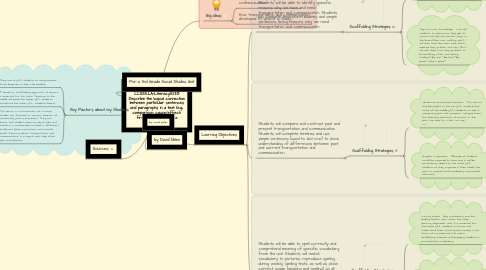
1. by David Eblen
2. For a 3rd Grade Social Studies Unit
3. Key Factors about my Students
3.1. They are all ELL students at varying levels - from beginner to high intermediate.
3.2. A tiered or scaffolding approach to lessons is essential for this class. Teaching to the middle will leave the higher ELL students bored and the lower ELL students behind.
3.3. This lesson is a continuation of a social studies unit focused on various aspects of community, past and present. The prior lesson had students learning about jobs and industry in communities located on different landforms (plains, mountains, and coastal lands). Learning about transportation and communication is a logical next step after jobs and industry.
4. Sources:
5. by David Eblen
6. Big Ideas
6.1. Why we need transportation and communication.
6.2. How transportation and communication developed to what it is today.
7. Learning Objectives
7.1. Students will be able to identify specific reasons why we have and need transportation and communication. Students will complete brainstorm bubbles and simple sentences listing reasons why we need transportation and communication.
7.1.1. Scaffolding Strategies
7.1.1.1. Intentional Small Group/Partner Work - Rather than forming mixed groups, high ELL students with lower ELL students, I will place similar leveled ELL students together. They will brainstorm ideas on why we need transportation and communication. During the activity I will spend most of my time with the lower ELL groups in helping them think of ideas.
7.1.1.2. Tap Into Prior Knowledge - I will ask students to share how they get to school and tally the various ways on the board (bus, car, walking, etc.). I will then have the class vote which method they prefer and why. Also, I will ask them how they go back to Korea (they often visit during holidays). By car? By bus? By plane? Why a plane?
7.2. Students will compare and contrast past and present transportation and communication. Students will complete timelines and use simple sentences (used to, but now) to show understanding of differences between past and current transportation and communication.
7.2.1. Scaffolding Strategies
7.2.1.1. Sentence Structures/Starters - This will not only be useful to the low ELL students but some of the middle ELL students as well. In comparing past with present, I will give them the following sentence structure: "In the past, we used to _______, but now we __________."
7.2.1.2. Graphic Organizers - Although all students would be required to have one, it will be particularly helpful to the lower ELL students as they organize in their heads the past vs. present and vocabulary associated with each.
7.3. Students will be able to spell correctly and comprehend meaning of specific vocabulary from the unit. Students will match vocabulary to pictures, reproduce spellng during weekly spelling tests, as well as show correct usage (meaning and spelling) on all class assignments.
7.3.1. Scaffolding Strategies
7.3.1.1. Strong Visuals - Key vocabulary are the building blocks upon which the other learning objectives rest. It is essential for the lower ELL students to know and understand them. Good visuals, usually in the form of a PowerPoint do well in estabilshing interest and engaging students in pre-teaching vocabulary..
7.3.1.2. Think Alouds - To help the low ELL students in the spelling of key vocabulary, I will slowly sound out each word as I write it on the board. (Ex. "Transportation.... hmmm,,, what letter do you think it starts with? Ta ... how about T? T r..... whats next? How about T r a.." Hopefully this will help them when they have to spell a word they don't know, they can sound it out to assist their spelling.
